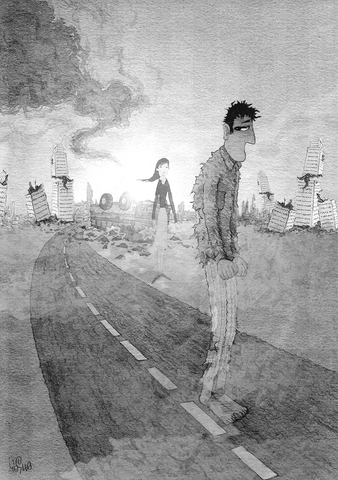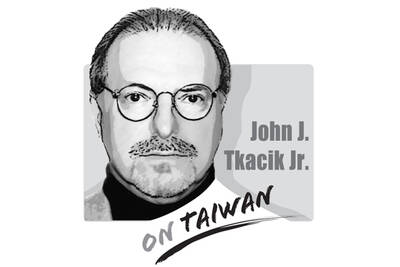A long with a group of faculty, staff and students from my university in Islamabad, I journeyed to Balakot, close to the center of the Kashmir earthquake.
This mountainous town, situated on the banks of the Kunhar River, has been destroyed. There is rubble and the gut-wrenching smell of decaying corpses. The rats have it good; the one I accidentally stepped upon was already fat. If there is a plan to clear the concrete rubble in and around the town, nobody seems to have any clue. But the Balakotis are taking it in their stride -- nose masks are everywhere.
But there is good news. We were just one of countless groups of ordinary citizens that were on the move after the enormity of last Saturday's earthquake became apparent. The Mansehra to Balakot road, finally forced open by huge army bulldozers, is now lined with relief trucks bursting with supplies that were donated by people from across the country. This is one of those rare times that I have seen Pakistan's people feel and move together as a nation. Even the armed bandits who waylay relief supplies -- making necessary a guard of soldiers with automatic weapons, standing every few hundred yards -- cannot destroy this moment.

ILLUSTRATION: YU SHA
Islamic groups from across the country have also arrived.? Some bring relief supplies; others simply harangue those who have lost loved ones and livelihoods, lecturing that their misdeeds brought about this catastrophe. None seem to have an explanation for why God's wrath was especially directed to mosques, madrassas, and schools -- all of which collapsed in huge numbers. None say why thousands of the faithful have been buried alive in this sacred month of fasting.
Aid from across the world is making its way towards the destruction, and the US is here, too. Double-bladed Chinook helicopters, diverted from fighting al-Qaeda in Afghanistan, now fly over the heartland of jihad and the militant training camps in Mansehra to drop food and tents a few miles beyond. Temporarily birds of peace instead of war, they do immensely more to calm angry Islamists than the reams of glossy propaganda put out by the US information services in Pakistan.
Their visibility makes relief choppers terrific propaganda, for good or for worse. This is undoubtedly why the Pakistani government refused an Indian offer to send in helicopters for relief work in and around Muzzafarabad, the flattened capital of Pakistani-administered Kashmir. Sadly, in spite of a much-celebrated peace process, Pakistan refuses visas to Indian peace groups and activists that seek to help in the relief effort. It is still not too late to open this door and let Pakistanis, Indians and Kashmiris help each other.?
The challenges are many. The aid remains too little. There are not enough tents, blankets, and warm clothes to go around.? Hundreds of tent clusters have come up, but thousands of families remain out under the skies, facing rain and hail, and with dread in their hearts.
These families have lost everything but the tattered clothes on their backs. Some even lost the land they had lived upon for generations -- the top soil simply slid away, leaving behind hard rock and rubble.
Worst of all, aid is not reaching those most affected. Hundreds of destroyed communities are scattered deep in the mountains. We saw helicopters attempt aerial drops; landing is impossible in most places. But people told us that they often miss and the supplies land up thousands of feet or below in deep forests. Distribution is haphazard and uncoordinated, done with little thought. We saw relief workers throw packets of food and clothes from the top of trucks, causing a riot. Hustlers thrive, the weak watch passively.
The clock is ticking. In two months, the mountains will get their first snowfall and temperatures will plummet below zero. Millions may have been made homeless. Those without shelter will die. Tents will not do.
From a special university fund, we pledged to rebuild the homes of a dozen families. But ten thousand or more families will need homes in the Mansehra-Balakot-Kaghan area alone, not to speak of adjoining Kashmir. The task of saving lives has barely begun.
For me personally, there is a sense of deja vu. Nearly 31 years ago, on Dec. 25, 1974, a powerful earthquake flattened towns along the Karakorum Highway and killed nearly 10,000 people. I traveled with a university team into the same mountains for similar relief work. Prime Minister Zulfiqar Ali Bhutto had made a passionate appeal for funds around the world, had taken a token helicopter trip to the destroyed town of Besham, and then made fantastic promises of relief and rehabilitation.
Hundreds of millions of dollars in relief funds received from abroad mysteriously disappeared. Some well-informed people believe that those funds were used to kick off Pakistan's secret nuclear program.
Will today's government do better? This will only be assured if citizens organize themselves to play a more direct role in relief and rehabilitation for the long term. Civil society groups must now assert themselves. They must demand a voice in planning and implementing the reconstruction effort and, along with international donors, transparency and public auditing of where aid is spent.
Pervez Hoodbhoy is a professor at Quaid-e-Azam University, Islamabad, Pakistan. Copyright: Project Syndicate
You wish every Taiwanese spoke English like I do. I was not born an anglophone, yet I am paid to write and speak in English. It is my working language and my primary idiom in private. I am more than bilingual: I think in English; it is my language now. Can you guess how many native English speakers I had as teachers in my entire life? Zero. I only lived in an English-speaking country, Australia, in my 30s, and it was because I was already fluent that I was able to live and pursue a career. English became my main language during adulthood

Somehow, US intelligence identified “the Houthis’ top missile guy” and pinpointed his exact location. At 1348 hours (Washington time), March 15, President Trump’s national security advisor Mike Waltz texted, “positive ID of him walking into his girlfriend’s building.” The unsuspecting Romeo entered. High above, the drone monitoring the building registered a flash. When the smoke cleared, Mr. Waltz texted, “…And it’s now collapsed.” RIP. The star-crossed “top missile guy” had been target number one in the now uproarious US Navy bombing campaign on that Sunday against the Yemeni rebels who have been holding the Red Sea hostage since October 19,
Taiwan on Monday celebrated Freedom of Speech Day. The commemoration is not an international day, and was first established in Tainan by President William Lai (賴清德) in 2012, when he was mayor of that city. The day was elevated to a national holiday in 2016 by then-president Tsai Ing-wen (蔡英文). Lai chose April 7, because it marks the anniversary of the death of democracy advocate Deng Nan-jung (鄭南榕), who started Freedom Era Weekly to promote freedom of expression. Thirty-six years ago, a warrant for Deng’s arrest had been issued after he refused to appear in court to answer charges of
The Opinion page has published several articles and editorials over the past few weeks addressing Taiwan’s efforts to leverage unique or strong aspects of its culture to increase international awareness of the nation. These have included submissions by foreign journalists and overseas students, highlighting how bubble milk tea, Guinness World Record attempts, the entertainment sectors, impressive scenery, world-class cuisine and important contributions to the high-tech supply chain can enhance Taiwan’s recognition overseas and therefore its soft power. That entails competing for attention in already crowded sectors. Other nations, after all, offer popular entertainment exports, beautiful scenic spots and great food.